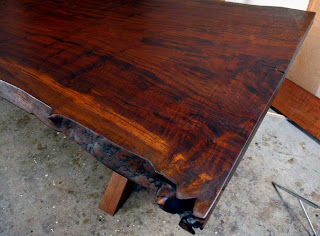
After the table arrived, we got the letter above ... "trumped the house" is a bit of an overstatment, but I think he did like his table ... Click the letter to enlarge it ...
3/3/08
The shippers will be picking up the big walnut slab dining table we have been working on for about a month now on Wednesday morning, and they will be taking it off to it's new home on the Snake river in Idaho, overlooking the Grand Tetons. I'm sorry to see it go. It is truly a one of a kind dining table. So, when it gets there, it will have started as a grafted tree in a walnut orchard in California, where it grew for a hundred years or so, than traveled across the country on a tractor trailer, as a log, to Pennsylvania, where it was sawed into planks, than air and kiln dried for three years before being shipped to Vermont to be made into the table you see below. I figure that's about 6000 miles and over a hundred years ... hope it makes it for at least another hundred ........ Double click the photos for better viewing.

A photographic challenge ... the table is 4' x 10', my finish room/ photo studio is 15' x 22'.

See below for structural details

Close up of the far end

Closer up of the far end
Here's the whole story .... from 2/9/08
We are currently working on a 48" x 10' walnut table made from a single 2 and a 1/2" thick slab of Claro walnut from California via
Good Hope hardwoods in Pennsylvania. the design is based on a
recycled chestnut table we made previously for another client. The table will have a classic "X" stretcher with a 1.25" solid twisted steel bar connector to reinforce and stiffen the base. The steel will be fabricated in our custom metal shop by my son Sam. The table top will be smoothed and polished using hand tools as it's too wide (49") and too heavy for any sander or planer that I know of locally. In the lower photos, we are in the early stages of the smoothing process and base construction, but hope to ship the table before the end of the month. The photos are posted in reverse order, with the most recent (today) at the top and going back in time to the start of the project. The table now has its base coats and will receive 3 or more polish coats next week before shipping it to Idaho.

In the finish room today ... a little cluttered, but too big for the background paper. Close, but not completely finished.
This photo actually was flipped from the upside down position (see below) and cut out in photoshop to show an uncluttered view of the structure which provides the rigidity to the heavy table top. The one and one quarter inch solid steel is welded to short threaded rods which then pass through and are bolted to the x shaped 'washers' which have previously been bolted to the xs. It's this steel structure that allows the +/- 300 pound top to sit with absolute rigidity on it's somewhat minimal base. It's like bumping into a pool table.
Claro walnut

close up of the slab before starting the finishing ...

In this photo, the assembled base with the twisted steel stretcher is upside down on the shop floor with the slab of the table in the background.

Sam, forging the twisted connector. Actually, it took two shots to get it right. The first time, Sam and his brother, after some discussion, accidentally made the two twists parallel, rather than opposed. Soooooo, they had to reheat the bar and straighten it, reheat it again and twist it in the right direction. Of course they didn't tell me this until after I had told them it looked great. And, really, you'd never know. It's pretty amazing to me that a chunk of inch and a quarter steel can become so flexible with just a little heating.... well, ok, a lot of heating.

The table in the first stages of smoothing with it's mocked up 'X' base. Tevor, the "x guy", aparently admiring his nails.







































